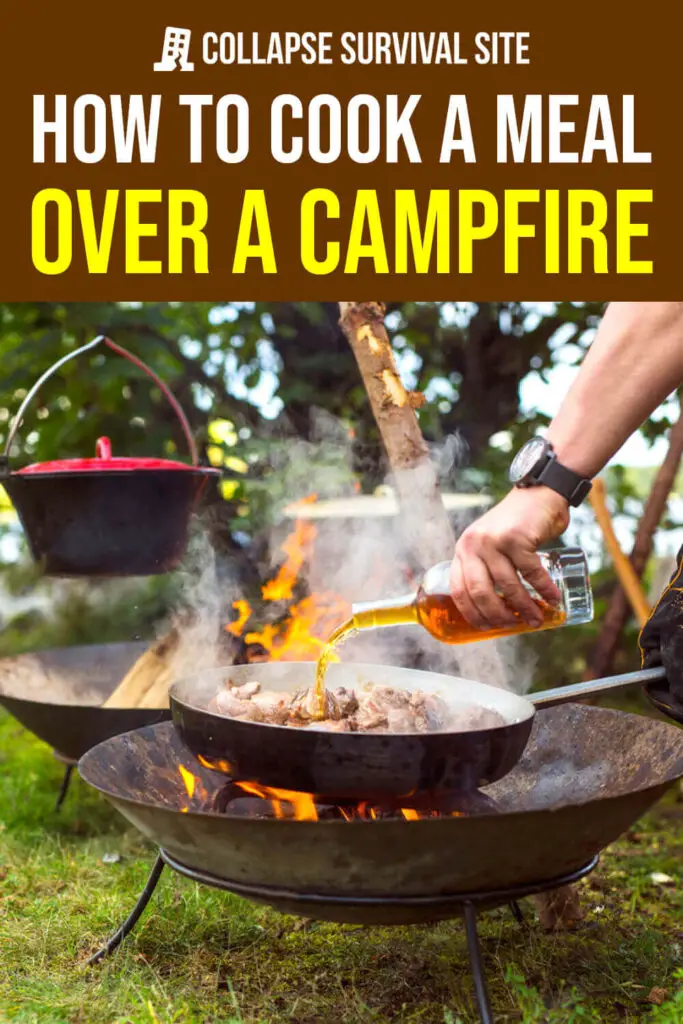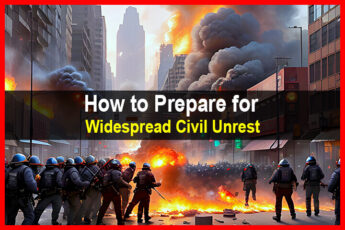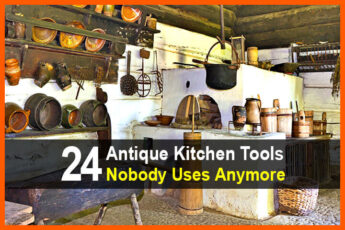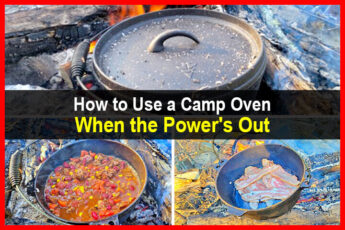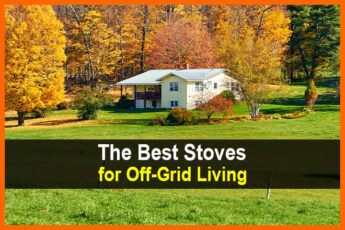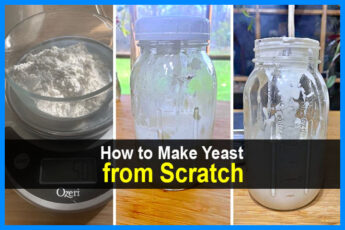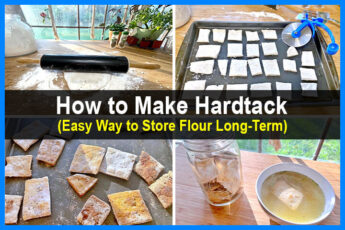Estimated reading time: 11 minutes
Cooking over a campfire is an age-old tradition that captures the essence of outdoor adventures. The smell of the fire, the crackling of the logs, and the shared camaraderie as everyone gathers around the blaze make for a truly rewarding experience.
But as much fun as it is, it's also a responsibility. Respect for nature and an understanding of how to manage a fire responsibly is fundamental to preserving the great outdoors for future generations to enjoy.
In this article, you'll learn not only how to cook delectable dishes over a campfire but also the principles of responsible fire management. You'll understand the importance of leaving no trace behind, ensuring your fire is completely extinguished, and why you should never leave a fire unattended.
Want to save this post for later? Click Here to Pin It On Pinterest!
Essential Equipment for Campfire Cooking
Before you set out on your adventure, ensure you're well-equipped with these essential tools designed for campfire cooking:
- Campfire cooking grate or tripod: This provides a stable surface to place your pots and pans over the fire. A grate is a flat, grid-like surface, whereas a tripod suspends pots above the fire with a chain.
- Cast iron skillet or Dutch oven: These heavy-duty cooking vessels distribute and retain heat evenly, making them perfect for everything from searing steak to baking cornbread.
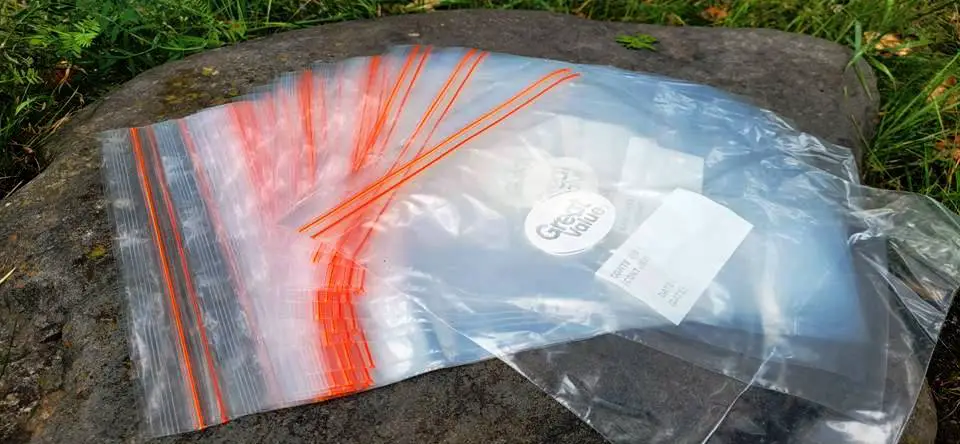
- Long-handled tongs and spatula: These are your primary tools for handling food on the fire. Their long handles keep your hands at a safe distance from the flames.
- Heat-resistant gloves: Authentic campfire cooking involves getting your hands near the flames, so ensure you have a pair of sturdy, heat-resistant gloves for protection.
- Aluminum foil and heavy-duty Ziploc bags: These are versatile items that you can use for wrapping food, cooking packet meals, or storing leftovers.
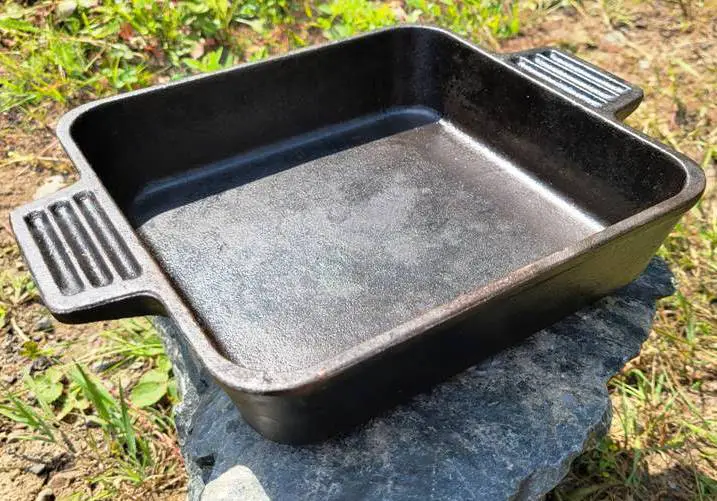
- Fire-starting tools (matches, lighter, or fire starters): Starting a fire is a basic yet essential skill in outdoor cooking. Always keep a reliable source of fire with you – be it matches, a lighter, or a fire starter kit.
Gathering your gear is the first step in the culinary journey of campfire cooking. With these tools at your disposal, you're well on your way to creating delicious meals
Safety First
Fire is an indispensable part of camping, providing warmth, light, and a source for cooking. However, it's crucial to exercise safety while handling it.
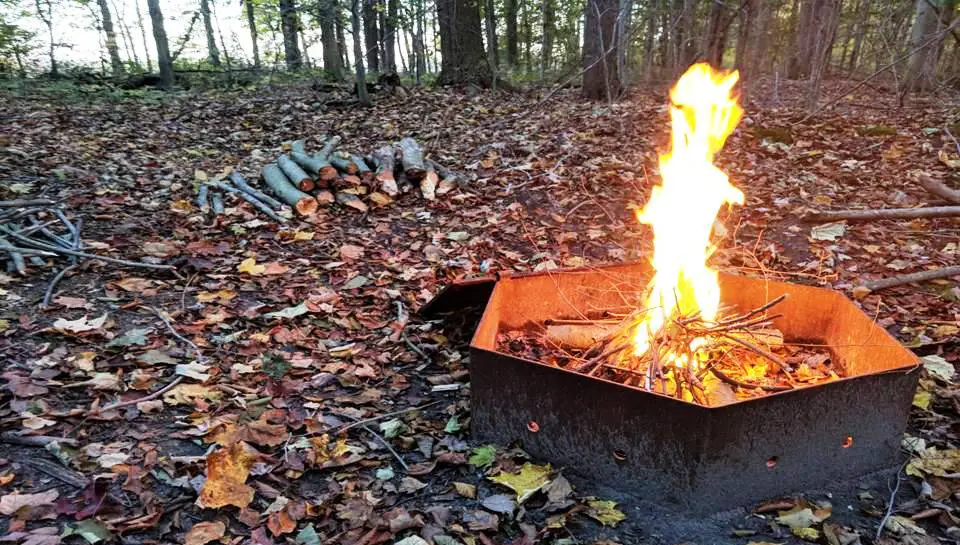
Here are some precautions to ensure a safe and enjoyable campfire cooking experience:
- Selecting a Safe Location: Always choose a flat, open spot for your campfire. Keep it away from tents, trees, or any flammable materials. Ensure there are no overhanging branches or shrubs that could catch fire.
- Clearing the Fire Area: Thoroughly clean the area around your fire pit. Remove any debris, dried leaves, or twigs that could potentially ignite. Ideally, the ground around the fire pit should be bare dirt or surrounded by rocks.
- Preparedness for Emergencies: Always keep a bucket of water or sand nearby when you have a fire going. In the event of an emergency, you can use these to quickly extinguish the flames. Never leave a fire unattended.
- Understanding Fire Regulations: Regulations vary from one location to another. You should always be aware of the local fire restrictions and regulations in your camping area. Some places might have specific rules about fire pits, or fires might be banned altogether during certain times of the year due to high fire risk.
Campfire cooking is an art that also demands respect for nature and awareness of the elements. Stay vigilant, respect fire safety norms and your outdoor culinary adventure will be as delightful as it is safe.
Choosing the Right Fire for Cooking
When it comes to outdoor cooking, the type of fire you build can greatly influence the success of your meal. The best type for cooking is the ‘cooking fire' or ‘log cabin fire'.

To create a cooking fire, start by placing two larger pieces of firewood parallel to each other. Add two more pieces on top, lying perpendicular to form a square. Continue this pattern until you have a structure that resembles a log cabin. In the center of this structure, place a small teepee fire made of kindling and smaller twigs.
Light the teepee fire and let it catch onto the ‘log cabin'. Allow the fire to burn down until you have a bed of hot coals. These coals provide a steady, even heat that is perfect for cooking.
Controlling Cooking Temperatures
Managing the temperature of your campfire is essential for cooking effectively and making the most of your outdoor culinary experience. Here are some techniques to help you control the heat of your campfire for a variety of cooking needs.
Building a Multi-Level Fire: To cater to different cooking requirements, you should aim to build a campfire that offers various levels of heat. Start with a high flame in the center for boiling, a medium flame on one side for simmering, and a bed of glowing embers on the other side for slow cooking or grilling.
Adjusting the Flame Size: The size of your fire directly affects the intensity of the heat. Making the fire larger will result in higher heat and vice versa. Remember, a larger fire will consume more fuel and can be harder to control. On the other hand, a smaller fire is easier to manage but might not provide sufficient heat for some cooking tasks.

Using Hot Coals: For many cooking methods, a bed of hot coals is preferable to an open flame. Coals provide consistent, even heat that's perfect for slow cooking, simmering, or roasting. Once you've got a good fire going, let it burn down until you have a base of hot, glowing coals.
Place your cooking pot or grill directly over these for best results. Cooking with hot coals allows for precise temperature control throughout the process.
Creating a Makeshift Oven: A reflector oven is a versatile outdoor cooking tool that uses radiant heat from the fire to cook your food, essentially transforming your campfire into a makeshift oven. It features a metal plate at the back that reflects the heat towards the front, where you place your food.
This design enables even heat distribution, perfect for baking bread, roasting meats, or even making pizza in the great outdoors.
Don't be discouraged if your first few meals aren't perfect. With time, you'll gain a better understanding of how to control your fire and cook delicious meals every time.
Filling and Easy-to-Cook Meal Ideas
Now that we've covered the basics of campfire cooking, let's move on to some meal ideas. These recipes are not only easy to prepare but also designed to be hearty and filling to fuel your outdoor adventures.

Foil-Wrapped Meals: Hearty Campfire Packets
One of the simplest methods to cook over a campfire, yet incredibly delicious, are foil-wrapped meals. These are essentially packages of food wrapped in aluminum foil and cooked directly on the hot coals. You can toss in your favorite protein – like chicken, fish, or tofu – and pair it with a mix of vegetables.
Don't forget to add some seasonings like garlic and onion powder for extra flavor. Seal the foil packet snugly and leave it on the coals to cook. The closed packet traps the steam, cooking the food evenly and locking in the flavors.
Skewers or Roasting Sticks: Fun and Flavorful Kebabs
Skewers make for a fun and interactive cooking experience. You can create delicious kebabs by threading pieces of marinated meat, vegetables, and even fruits onto a long stick or metal skewer. Rotating them over the fire will evenly cook them. The result is a smoky, grilled delicacy that's easy to eat and clean up.
One-Pot Meals: Savory Comfort Food in the Wilderness
A Dutch oven is a great tool for campfire cooking, allowing you to prepare a range of one-pot meals. From savory stews, heart-warming chili, to comforting soups, the possibilities are endless. You can combine a variety of ingredients, let it simmer over the hot coals, and have a filling meal ready with minimal effort.
Grilled Sandwiches: Simple Yet Satisfying
Nothing beats the taste of a grilled sandwich over a campfire. You can make grilled cheese, paninis, or your own creative sandwich combinations. These are easy to prepare, require few ingredients, and are incredibly satisfying after a day of outdoor activities. Just place your assembled sandwich on the grill or in a sandwich toaster, and cook it over the fire until it's perfectly toasted.
Campfire cooking is about simplicity, creativity, and fun. Don't worry if your meals are not restaurant-quality. The important thing is to enjoy the process, experiment with flavors, and savor the experience of cooking in the great outdoors.
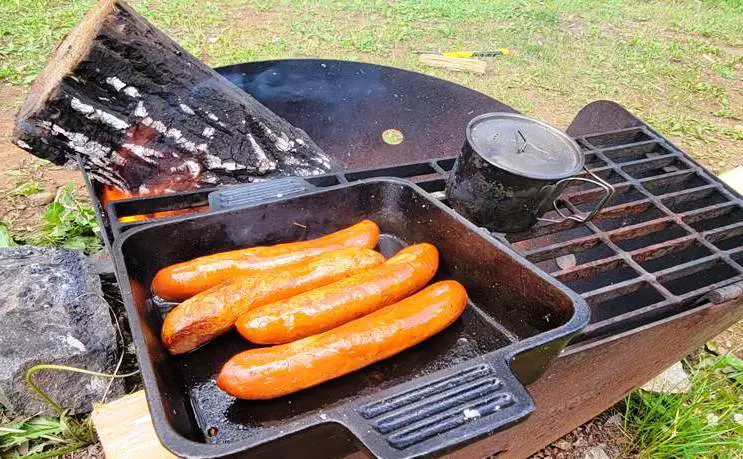
Don't Forget The Sides
No campfire meal is complete without a selection of delectable sides to balance your palate and round out your dining experience. Here are easy and flavorsome side dishes you can prepare in the great outdoors.
- Grilled corn on the cob: Buttered, seasoned, and wrapped in foil.
- Campfire bread: Easy dough recipes cooked on a stick or in a skillet. Here's a delicious campfire bread recipe to try: campfire bread recipe.
- Roasted vegetables: Carrots, bell peppers, onions, or zucchini with olive oil and spices.
- Foil-wrapped potatoes: Baked potatoes with various toppings including bacon bits, green onions, chives, and cheese. Check out this easy recipe for foil-wrapped potatoes over a campfire: campfire foil-wrapped potatoes recipe
The joy in campfire cooking is all about embracing the rustic and communal experience, as well as enjoying the simplicity of food prepared outdoors.
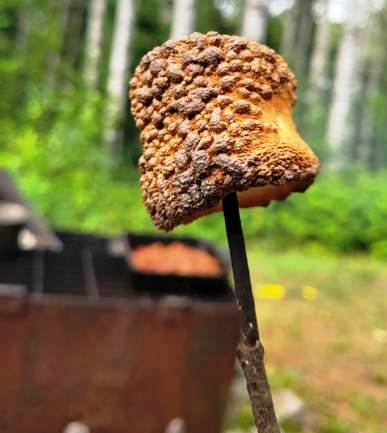
Cleaning Up Afterward
Enjoying a meal cooked over a campfire is a wonderful experience, but it's important not to neglect the clean-up process afterward. Following appropriate steps ensures your camping spot remains pristine for others to enjoy and is an integral part of responsible outdoor behavior.
Firstly, allow the fire to burn down completely to ashes. Once it's reduced to ashes and cooled down, be sure to scatter them away from the campsite, at a safe distance from any potential fire hazards.
Next, any cookware used should be thoroughly cleaned. Use biodegradable soap and hot water to minimize your impact on the environment. Be sure to do your washing away from any water sources to prevent contamination. If you don’t have any abrasive scrubbing pads, use sand, moss, or cedar leaves to get any tough spots clean.
Lastly, the principle of ‘Leave No Trace' should be upheld. This means packing out all waste and garbage. If you carried it in, you should carry it out. Leaving anything behind is not just unsightly; it can pose a threat to local wildlife and the integrity of the ecosystem.
Cleaning up after a campfire meal is just as important as cooking and eating. By following these steps, you're doing your part to protect our beautiful outdoor spaces for future generations to enjoy.
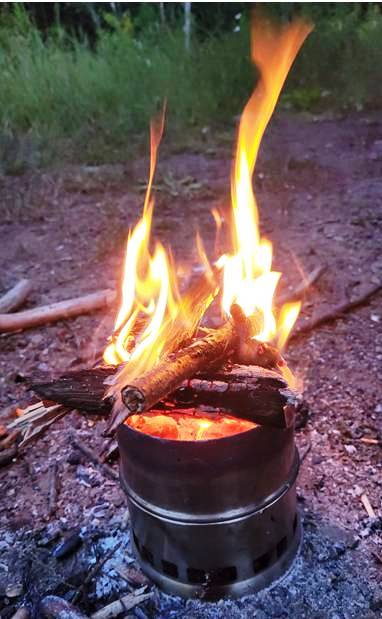
Final Thoughts
Once you get a handle on managing temperatures and ingredients without the convenience of a fridge, cooking outdoors can be just as straightforward and enjoyable as cooking in your kitchen. Trading the predictability of a controlled environment for the challenge and adventure of the great outdoors can open up a world of culinary possibilities.
Don’t be afraid to experiment with different recipes and push your boundaries. Remember, every great cook started as a beginner. As you embark on your open-fire cooking journey, bear in mind the importance of respecting the environment. After all, the beauty of nature is what makes outdoor cooking such a unique and memorable experience.
Like this post? Don't Forget to Pin It On Pinterest!

